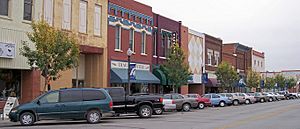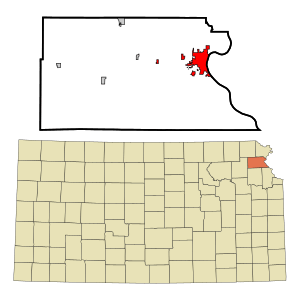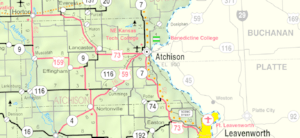Atchison, Kansas facts for kids
Quick facts for kids
Atchison, Kansas
|
||
|---|---|---|
|
City and County seat
|
||

Commercial Street in downtown Atchison (2006)
|
||
|
||

Location within Atchison County and Kansas
|
||

|
||
| Country | United States | |
| State | Kansas | |
| County | Atchison | |
| Township | Shannon | |
| Founded | 1854 | |
| Incorporated | 1855 | |
| Named for | David Rice Atchison | |
| Government | ||
| • Type | Council-Manager | |
| Area | ||
| • Total | 8.47 sq mi (21.93 km2) | |
| • Land | 8.01 sq mi (20.75 km2) | |
| • Water | 0.46 sq mi (1.18 km2) | |
| Elevation | 869 ft (265 m) | |
| Population
(2020)
|
||
| • Total | 10,885 | |
| • Density | 1,285.1/sq mi (496.35/km2) | |
| Time zone | UTC-6 (CST) | |
| • Summer (DST) | UTC-5 (CDT) | |
| ZIP code |
66002
|
|
| Area code | 913 | |
| FIPS code | 20-02900 | |
| GNIS ID | 485542 | |
Atchison is a city in Kansas, United States. It is the county seat of Atchison County. The city is located along the Missouri River. In 2020, about 10,885 people lived here.
Atchison is named after US Senator David Rice Atchison from Missouri. It was once the main eastern stop for the Atchison, Topeka and Santa Fe Railway. Today, Atchison is also home to Benedictine College.
Contents
History
How Atchison Was Founded
Atchison was started in 1854. It was named after Senator David Rice Atchison. He encouraged friends to create a city in the new Kansas Territory. Senator Atchison wanted the new territory to support slavery.
Not everyone agreed on the best spot for the city. On July 20, 1854, a group of men left Platte City, Missouri. They wanted to find the perfect location. They found a good spot near the river. This area was great for farming.
The town company officially started with 18 people. They chose Peter T. Abell as president. The land was divided into 100 shares. Each member kept five shares. The rest were for the town's benefit.
By September 20, 1854, Henry Kuhn had mapped out the 480 acres (1.9 km2). The next day, lots were sold. Senator Atchison gave a speech about the politics of the time. Two important things were planned: a hotel and a newspaper. The National Hotel was finished in 1855. A printing office was also built for a newspaper.
The Squatter Sovereign newspaper began on February 3, 1855. It strongly supported slavery. Later, in 1857, new owners changed it to a free-state paper.
The first post office in Atchison opened on April 10, 1855. It was in a small building. In 1883, mail delivery to homes began.
Atchison became a trade center in 1855. Many freight companies chose Atchison as their starting point. Early businesses helped the town grow.
On August 30, 1855, Atchison officially became a city. More areas were added to the city in the following years.
Until 1858, the city mostly supported slavery. But by that year, those against slavery gained control. On February 12, 1858, the state gave Atchison its city charter. The first city leaders were elected on March 13, 1858. Samuel C. Pomeroy became the first mayor.
Early Schools
The first schools in Atchison were private. Some were run by German Catholic groups. One of the first English schools opened in 1857. The first public school district started in October 1858. A month later, Atchison's free high school opened.
Atchison During the Civil War
When the American Civil War began, Atchison formed three local army groups. Their members joined Kansas regiments. In September 1861, a home guard was created. This group protected the town from attacks from Missouri.
In 1863, Atchison raised $4,000 to help soldiers from the county. After the Lawrence Massacre, the city also helped people in Lawrence. Citizens also joined groups to stop crime. These groups helped the police against lawless gangs.
During the war, Atchison was also a base for groups called jayhawkers. These groups often raided Missouri. One famous jayhawker was Charles Metz. He stole many horses from Missouri farmers. He also robbed people who supported the South. Metz even forced Atchison's first president, P.T. Abell, to leave town. Metz was killed in 1862.
Growth of Industry
In the late 1850s, people planned to connect California by rail. Atchison wanted to be the eastern end of this railroad. To help this, a rail line was built from St. Joseph, Missouri to Atchison. This line was finished between 1857 and 1859. Atchison citizens helped pay for it.
The Atchison and Topeka Railroad started in 1859. Atchison was its eastern end. The goal was to connect Kansas to the southwest by rail. The Civil War delayed building. But in 1863, the government gave land for the railroad. This land went to the new Atchison, Topeka, and Santa Fe Railroad (AT&SF). Building started in 1868 in Topeka. The connection between Atchison and Topeka was finished in May 1872.
Atchison tried to become a major railroad hub. But it was passed by Kansas City and Omaha. These cities had more industry and better connections. Atchison's leaders also disagreed on which projects to focus on. This slowed down building important things like bridges and warehouses.
However, with the railroad connections, industry came to Atchison. Grain elevators, flour mills, and a flax mill were built. In 1872, Captain John Seaton moved his foundry to Atchison. His company, the Atchison Foundry and Machine Works, grew quickly. It made things like iron fences and staircases. It employed over 200 men.
In 1905, the Locomotive Finished Materials Company (LFM) started. It made parts for train engines. In 1914, Seaton's foundry and LFM merged.
John Seaton became a very important person in Atchison. He owned a theater and served in government. He died in 1912.
In 1914, Harry Muchnic invented a new part for diesel train engines. In 1924, the John Seaton Foundry started using steel. This helped the change from steam to diesel trains. By 1938, LFM was making many parts for General Motors.
In 1958, Rockwell bought LFM Steel Foundry. They made parts for train trucks. In 1991, it was renamed Atchison Casting Corporation (ACC). ACC became a public company in 1994. Today, the foundry mostly makes parts for trains. It makes parts for commuter trains in big cities like San Francisco and Chicago. It is now owned by Bradken, a company from Australia.
Geography
Atchison is on the western side of the Missouri River. This river is also the border between Kansas and Missouri. The city is located where U.S. Route 59 and U.S. Route 73 meet. It is about 21 miles (34 km) southwest of St. Joseph, Missouri. It is also 25 miles (40 km) northwest of Leavenworth, Kansas.
The United States Census Bureau says the city covers 8.29 square miles (21.5 km2). Most of this is land, and a small part is water.
Climate in Atchison
Atchison has a climate with warm summers. Temperatures change a lot throughout the year. In January, the average low is about 18.4°F (-7.6°C). In July, the average high is about 87.6°F (30.9°C).
The temperature reaches 90°F (32°C) about 38 days a year. It reaches 100°F (38°C) about 3 days a year. The temperature drops below freezing (32°F or 0°C) about 107 days a year. The first freeze usually happens in late October or early November. The last freeze is usually in late March or April.
The area gets about 36.38 inches (924 mm) of rain each year. Most rain falls in May, June, and July. It snows about 17 inches (43 cm) each winter. Snow falls on about 10 days a year.
| Climate data for Atchison, Kansas (1991–2020 normals, extremes 1893–2009) | |||||||||||||
|---|---|---|---|---|---|---|---|---|---|---|---|---|---|
| Month | Jan | Feb | Mar | Apr | May | Jun | Jul | Aug | Sep | Oct | Nov | Dec | Year |
| Record high °F (°C) | 72 (22) |
84 (29) |
93 (34) |
95 (35) |
103 (39) |
106 (41) |
109 (43) |
111 (44) |
108 (42) |
98 (37) |
84 (29) |
74 (23) |
111 (44) |
| Mean daily maximum °F (°C) | 36.2 (2.3) |
41.6 (5.3) |
54.0 (12.2) |
65.0 (18.3) |
74.4 (23.6) |
83.7 (28.7) |
87.6 (30.9) |
86.4 (30.2) |
78.9 (26.1) |
66.6 (19.2) |
51.9 (11.1) |
40.1 (4.5) |
63.9 (17.7) |
| Daily mean °F (°C) | 27.3 (−2.6) |
32.2 (0.1) |
43.2 (6.2) |
54.0 (12.2) |
64.9 (18.3) |
74.4 (23.6) |
78.4 (25.8) |
76.5 (24.7) |
68.5 (20.3) |
56.4 (13.6) |
42.6 (5.9) |
31.8 (−0.1) |
54.2 (12.3) |
| Mean daily minimum °F (°C) | 18.4 (−7.6) |
22.8 (−5.1) |
32.4 (0.2) |
42.9 (6.1) |
55.4 (13.0) |
65.2 (18.4) |
69.3 (20.7) |
66.5 (19.2) |
58.1 (14.5) |
46.2 (7.9) |
33.3 (0.7) |
23.4 (−4.8) |
44.5 (6.9) |
| Record low °F (°C) | −28 (−33) |
−25 (−32) |
−10 (−23) |
8 (−13) |
23 (−5) |
40 (4) |
46 (8) |
43 (6) |
30 (−1) |
11 (−12) |
−2 (−19) |
−21 (−29) |
−28 (−33) |
| Average precipitation inches (mm) | 0.93 (24) |
1.20 (30) |
1.92 (49) |
3.42 (87) |
5.32 (135) |
4.87 (124) |
5.17 (131) |
3.75 (95) |
3.48 (88) |
3.10 (79) |
1.81 (46) |
1.41 (36) |
36.38 (924) |
| Average snowfall inches (cm) | 5.0 (13) |
4.8 (12) |
1.8 (4.6) |
0.4 (1.0) |
0.0 (0.0) |
0.0 (0.0) |
0.0 (0.0) |
0.0 (0.0) |
0.0 (0.0) |
0.3 (0.76) |
0.9 (2.3) |
3.8 (9.7) |
17.0 (43) |
| Average precipitation days (≥ 0.01 in) | 5.0 | 5.0 | 7.3 | 9.6 | 11.1 | 9.6 | 8.7 | 8.0 | 7.6 | 6.9 | 5.2 | 5.0 | 89.0 |
| Average snowy days (≥ 0.1 in) | 2.9 | 2.4 | 0.9 | 0.3 | 0.0 | 0.0 | 0.0 | 0.0 | 0.0 | 0.1 | 0.6 | 2.5 | 9.7 |
| Source: NOAA | |||||||||||||
Population of Atchison
| Historical population | |||
|---|---|---|---|
| Census | Pop. | %± | |
| 1860 | 2,616 | — | |
| 1870 | 7,054 | 169.6% | |
| 1880 | 15,105 | 114.1% | |
| 1890 | 13,963 | −7.6% | |
| 1900 | 15,722 | 12.6% | |
| 1910 | 16,429 | 4.5% | |
| 1920 | 12,630 | −23.1% | |
| 1930 | 13,024 | 3.1% | |
| 1940 | 12,648 | −2.9% | |
| 1950 | 12,792 | 1.1% | |
| 1960 | 12,529 | −2.1% | |
| 1970 | 12,565 | 0.3% | |
| 1980 | 11,407 | −9.2% | |
| 1990 | 10,656 | −6.6% | |
| 2000 | 10,232 | −4.0% | |
| 2010 | 11,021 | 7.7% | |
| 2020 | 10,885 | −1.2% | |
| U.S. Decennial Census 2010-2020 |
|||
2020 Census Information
The 2020 United States census counted 10,885 people in Atchison. There were 3,871 households and 2,255 families. The population density was about 1,358 people per square mile (524.5/km2).
Most residents (82.33%) were white. About 6.84% were black. Other groups included Native American, Asian, and people of two or more races. About 4.69% of the population was Hispanic or Latino.
About 28.7% of households had children under 18. About 39.2% were married couples. The average household had 2.4 people. The average family had 3.0 people.
About 22.0% of the population was under 18 years old. About 20.4% were between 18 and 24. The median age in the city was 31.7 years. For every 100 females, there were about 109.7 males.
2010 Census Information
In the census of 2010, Atchison had 11,021 people. There were 3,933 households and 2,447 families. The population density was about 1,407 people per square mile (543.4/km2).
The racial makeup was 87.9% White. About 7.2% were African American. Other groups included Native American and Asian. About 2.7% of the population was Hispanic or Latino.
About 33.0% of households had children under 18. About 43.0% were married couples. The average household size was 2.45 people. The average family size was 3.08 people.
The median age in the city was 31.6 years. About 23.7% of residents were under 18. About 18.6% were between 18 and 24.
Education
Colleges in Atchison
- Benedictine College
- Northeast Kansas Technical College
- Highland Community College Technical Center
Schools in Atchison
The public schools in Atchison are part of Atchison USD 409. This district has four schools and serves over 1,600 students. In 1997, the public schools closed six smaller buildings. They opened one large elementary school instead. This helped bring together students from different parts of the city. One old school, Lincoln school, was once a separate school for black children. People are trying to restore it today.
- Atchison High School, for grades 9–12
- Atchison Middle School, for grades 6–8
- Atchison Elementary School, for grades K–5
- Atchison Alternative School, for grades 6-12
Private schools in Atchison include:
- Maur Hill Mount Academy
- Trinity Lutheran School
- St. Benedict Catholic School (was called Atchison Catholic Elementary School until 2013)
Notable People
Many interesting people have connections to Atchison:
- Willis J. Bailey, a U.S. Representative and governor.
- Frank L. Boyd (1881–1962), a labor organizer.
- Laura M. Cobb, a United States Navy nurse during World War II.
- Amelia Earhart, a famous aviator (pilot).
- Rory Lee Feek, a songwriter and country music artist.
- James Carroll Fox, a United States judge.
- George W. Glick, a former governor of Kansas.
- Sheffield Ingalls, a former lieutenant governor of Kansas.
- John James Ingalls, a former U.S. senator who created Kansas's motto.
- James Edmund Jeffries, a U.S. Congressman.
- Ernie Jennings, a football player.
- Oscar Johnson, a baseball player for the Kansas City Monarchs.
- Victor Linley, a Wisconsin State Senator.
- Paul Christoph Mangelsdorf, a botanist known for his work on maize (corn).
- John Alexander Martin, a former governor of Kansas.
- Chester L. Mize, a U.S. Congressman.
- James M. Stanton, a bishop.
- Jesse Stone, a musician and songwriter who helped create rock 'n' roll music.
Points of Interest
- National Register of Historic Places listings in Atchison County, Kansas
- Amelia Earhart Birthplace Museum
- Santa Fe Depot Rail Museum
- International Forest of Friendship, a special tree park
- Sallie House, a reportedly haunted house
See Also
 In Spanish: Atchison (Kansas) para niños
In Spanish: Atchison (Kansas) para niños







